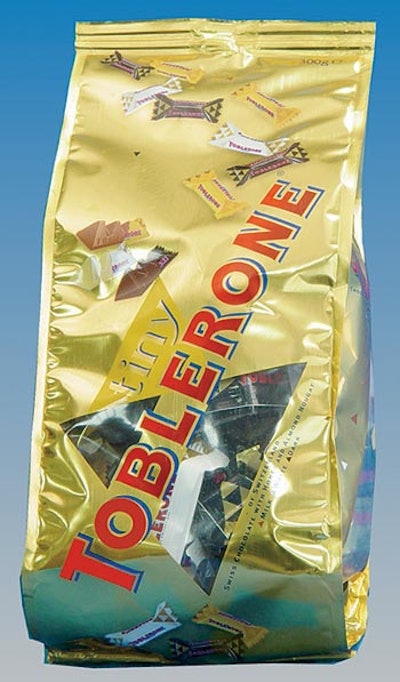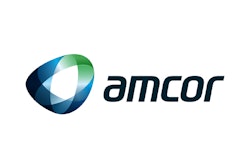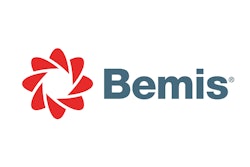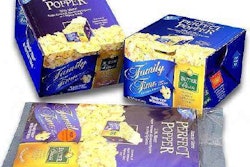
Technology is playing a vital role in the futuristic look and feel of several new flexible packages. So says the Flexible Packaging Assn. in announcing the winners of its 2004 Flexible Packaging Achievement Awards.
Entries for the competition swelled to a record 126 this year, with 28 packages receiving 36 total awards. For the fourth straight year, Highest Achievement Awards were given to two packages. They are covered in this report. All Gold-award winners will be covered separately on the home page of Packworld.com.
One of the Highest Achievement winners was Kraft’s Tiny Toblerone stand-up candy pouch "whose stunning good looks are achieved through a revolutionary new in-line demetallization process," according to FPA.
A Highest Achievement designation was also earned for Cardinal Health’s DelPouch Single Dose Frangible Applica-tor that FPA says "offers an innovative method of delivering ointments and creams in a single-dose flexible package."
The outer 300-g pouch for Kraft Foods’ individually wrapped Tiny Toblerone-brand candies also earned Gold awards in the Environmental, Printing, and Technical categories. To produce the outer pouch, converter Amcor Flexibles employed its Amcor DeMetXP in-line demetallization process. The Tiny bags are made at Amcor Flexibles’ Halen plant in Belgium.
The first step is eight-color gravure printing on the surface of an oriented polypropylene film, done on a Rotomec press. That outer film is adhesive-laminated to a layer of metallized OPP. Total thickness is 2 mils. Guy Grossard, Amcor’s product manager, says, "the primary wrap on the individual pieces takes care of the barrier needs." After laminating, the structure goes through a demetallizing bath.
Grossard explains, "We print, laminate, and demetallize in-line on equipment we modified. By doing it in-line, we have better control over quality, and we can see immediately the effect of the demetallization. In a more traditional process, you would print, apply lacquer, rewind the film, then send it through a separate demetallization step. If anything was wrong, you wouldn’t notice it until afterwards. With this process you [create] less waste."
Another advantage of the in-line process, Grossard says, "is that it doesn’t wash away the metal. Traditional demetallization attacks everything that is not protected by the lacquer, washing away a thin layer of aluminum." With the DeMet process, the metal layer is not removed from the film, but rather, "the chemical reaction turns the aluminum into a transparent layer," says Grossard. "It provides an advantage for us because it doesn’t produce the environmentally unfriendly waste water," common with the traditional process.
But the critical advantage is the result: a stunning gold metallic look and triangular clear windows on what will become the front and two sides of the pouch. Together, the graphics and windows of the outer pouch complement the metallic-looking graphics on the individually wrapped candies that are visible to consumers through the windows.
Grossard says, "You could just print onto a transparent bag, but then you’d have a totally different look on the outer pouch compared to the primary packages. And if you wanted to achieve the metallized look of the primary pack, you would need to use very expensive metal inks."
Tiny Toblerone was launched in January. They’re sold globally, primarily in travel and duty-free shops at airports and on cruise ships. Each package contains three basic flavors: milk, dark, and white chocolate. Kraft worked with a third-party firm to create bag graphics. Product is produced at a Kraft Foods confectionery plant in Switzerland, according to Elisabeth Misteli, manager of communications for Kraft Foods, Bern, Switzerland.
"Tiny Toblerone are individually flow-wrapped," she says, "and the hermetic foils provide the best protection and hygiene for the chocolates." Misteli says the product has a 12-month shelf life.
"The stand-up bag is unique," she says, adding, "Toblerone is the first-and-only registered shape for chocolate, and is the ultimate symbol for Swiss chocolate worldwide. The triangularity is reflected in the three triangular windows." So the package design identifies the candy’s three-sided shape, with three peaks, three flavors, and three windows. "This background communicates the idea of a new Toblerone generation," Misteli concludes.
Versatile applicator package
A highly engineered structure—and custom fabrication equipment—is the key to the development of the DelPouchTM. The pouch is called a "single-dose frangible applicator" and the concept is patented by Cardinal Health Pharmaceutical Technologies & Services, the Somerset, NJ-based healthcare provider that will make and fill the pouches.
The award went to Pechiney Plastic Packaging, the company that developed the substrate for Cardinal. At the outset, says James Sikorsky, corporate business development manager of Pechiney, the new pouches will be used for topical creams and ointments. What makes the DelPouch unique is that a consumer simply squeezes the pouch to break the frangible seal. That releases the product into a foam applicator heat-sealed to the top of the small pouch. Aside from the frangible seal, the pouch is sealed on contoured sides and bottom at high temperature for lock-up seals.
Under development for more than two years, the substrate had to be able to hold a variety of liquids and creams, according to Bruce Detwiler, Cardinal’s senior project engineer. The first Cardinal product in the DelPouch is a medical application: a product to treat a skin discoloration issue in Africa.
"Originally, we expected to have this product ready for our fourth quarter that ends in June ’04," Detwiler says. "Now, it looks like it’ll be launched sometime later this coming summer." The project was delayed when Cardinal switched pouch printers and it discovered seal contamination.
However, Detwiler points out, Cardinal is looking at products as diverse as cosmetics to prescription drugs, what he calls "at least 50 good business opportunities" for this technology. "They didn’t make it easy on us," Pechiney’s Sikorsky says. "Cardinal Health wanted a lamination that it could use across every possible type of application. What it didn’t want was different specs for different products."
When Cardinal produced the list of products it wanted to fill into the pouch, organic chemists at Pechiney’s technical center in Neenah, WI, went to work to identify aggressive, volatile molecules in the products that could attack the packaging materials.
The result is what Sikorsky calls a "tank." The 5¼-mil material is what he calls a hybrid, combining both an adhesive and an extrusion lamination. The frangible seal is provided by a seven-layer coextruded blown film that incorporates high-density polyethylene and ethylene vinyl alcohol copolymer. This is adhesive-laminated to a polyester that Sikorsky says offers "an amorphous-type barrier." Above the polyester is another adhesive followed by 0.00035" aluminum foil. On top of the foil is another coextrusion of white low-density PE and ethylene acrylic acid, followed by a surface layer of polyester. "You can pretty much put anything in that," Sikorsky says.
Detwiler says that while Pechiney was developing the structure, he worked with Harro Höfliger to develop a custom machine that would convert the rollstock into the pouch and seal the foam applicator at the top. Currently, tooling is available for what he calls a 0.5-g dispensing size and another that holds twice as much. However, he says the machinery is flexible enough that it could probably produce pouches up to 3 to 4 g in capacity.
Because of adhesion, Cardinal uses a polyester/polyurethane-blended foam piece from Foamex. Depending on the viscosity of the product, the foam selected will have differing densities. "We’ve packaged products from a viscosity level of one, like water, up to 90ꯠ centipoises," he notes. The size of the foam disk can also be adjusted as needed. Secondary packaging will be required to keep the foam sanitary.
Surprisingly, Detwiler says that adjustments to the seals for different levels of frangibility are relatively simple. "To change 5 psi in force to break the seal, we only have to change the seal temperature one degree Celsius," he states, adding that dwell time and machine speeds stay the same.
Even though the first product is still months away from the market, Cardinal is already looking at twin-compartment pouches that could be used to package a powder and a diluent.
"The structure that Pechiney developed for this is definitely one-of-a-kind," Detwiler admits. "I give them all the credit in the world."


























